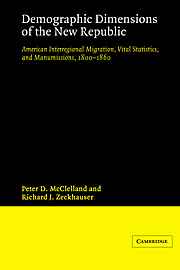 Demographic Dimensions of the New Republic
Demographic Dimensions of the New Republic Published online by Cambridge University Press: 19 September 2009
General
(a) The problem. Of all numerical series that document the progress of a nation, none is more fundamental than its population statistics. In the changing patterns of birth and death rates, population expansion and migration, can be found the quantitative strands indispensable to weaving any larger tapestry of the economic history of a people. Without them, the larger picture is incomplete. This study attempts the first comprehensive analysis of vital statistics and migration patterns within the United States between the Revolution and the Civil War. It is anchored in the one available source for nation-wide estimates, the decennial censuses, and supplemented wherever possible by other relevant data. It attempts to provide, for black and white populations, a consistent set of estimates of birth and death rates, rates of natural increase, and net international and interregional flows. For the black population, it also estimates the changing pace of manumissions in the ante-bellum decades. In short, the goal of this work is to provide the demographic components too long absent from the historical and demographic analysis of the period. The results are twofold: a set of data and a set of questions suggested by the data that promise novel challenges for historians of the ante-bellum era.
In the most aggregate of demographic data, puzzling patterns are not difficult to find. As indicated in Table A-l, the North American rate of increase was unequaled on any other continent during the first half of the nineteenth century.
To save this book to your Kindle, first ensure [email protected] is added to your Approved Personal Document E-mail List under your Personal Document Settings on the Manage Your Content and Devices page of your Amazon account. Then enter the ‘name’ part of your Kindle email address below. Find out more about saving to your Kindle.
Note you can select to save to either the @free.kindle.com or @kindle.com variations. ‘@free.kindle.com’ emails are free but can only be saved to your device when it is connected to wi-fi. ‘@kindle.com’ emails can be delivered even when you are not connected to wi-fi, but note that service fees apply.
Find out more about the Kindle Personal Document Service.
To save content items to your account, please confirm that you agree to abide by our usage policies. If this is the first time you use this feature, you will be asked to authorise Cambridge Core to connect with your account. Find out more about saving content to Dropbox.
To save content items to your account, please confirm that you agree to abide by our usage policies. If this is the first time you use this feature, you will be asked to authorise Cambridge Core to connect with your account. Find out more about saving content to Google Drive.